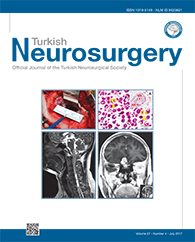2Wayne State University, School of Medicine, Department of Neurosurgery, Detroit, USA
3Blood Purification Center, Affiliated Ri Zhao Peoples Hospital, Ji Ning Medical College, Ri Zhao, Shan Dong Province, China
4Qingdao University, The Affiliated Hospital of Medical College, Department of Neurosurgery, Qingdao, China DOI : 10.5137/1019-5149.JTN.16456-15.1 AIM: To identify whether neuronavigation-assisted aspiration (NA) combined with electro-acupuncture (EA) provides better motor recovery in events of hypertensive putaminal hematoma (HPH) sized 30 to 50 ml. This study aims to examine whether neuronavigation-assisted aspiration and electro-acupuncture have additional value to cerebral hemorrhage motor rehabilitation.
MATERIAL and METHODS: 240 patients with HPH sized 30 to 50 ml and admitted within 6 to 10 hours after stroke ictus were included in this study. Group 1 contained 60 patients who underwent neuronavigation-assisted aspiration and electro-acupuncture (NAEA), group 2 contained 60 patients who underwent neuronavigation-assisted aspiration (NA), group 3 contained 60 patients who underwent electro-acupuncture (EA), and group 4 contained 60 patients who received conservative therapy consisting solely of medications. All the patients received the same therapeutic plan on admission and functional exercises three days after stroke onset. Electro-acupuncture was performed on the third day of admission; motor recovery was examined on weeks zero and eight by blinded assessors. Outcome measures included Fugl-Meyer assessment, modified Ashworth Scale and Functional Independence Measure.
RESULTS: Group one showed significantly improved motor outcomes compared to group four (p<0.01). Group one also showed significant motor improvement when pre-and post- therapy functioning was examined (p<0.01). Cerebral edema and ischemia were significantly decreased in group one compared to group 3 and 4 (p<0.05). While not as effective as group one treatment, group two and group three patients had significant motor recovery after intervention when compared to group four (p<0.05). Muscular tension secondary to stroke was considerably improved between group one and group four, group two and group four, group three and group four respectively (p<0.05). Activities of daily living (ADL) improved a lot with EA together with NA.
CONCLUSION: Neuronavigation-assisted aspiration and electro-acupuncture of HPH at the early stage can provide improved motor recovery with fewer complications. Significant motor recovery can be achieved by neuronavigation-assisted aspiration with acupuncture. Based on our findings, we recommend early intervention with NA and EA in order to promote early rehabilitation of hemiplegia secondary to HPH.
Keywords : Neuronavigation-assisted aspiration, Hypertensive putaminal hematoma, Electro-acupuncture, Hemiplegia rehabilitation




